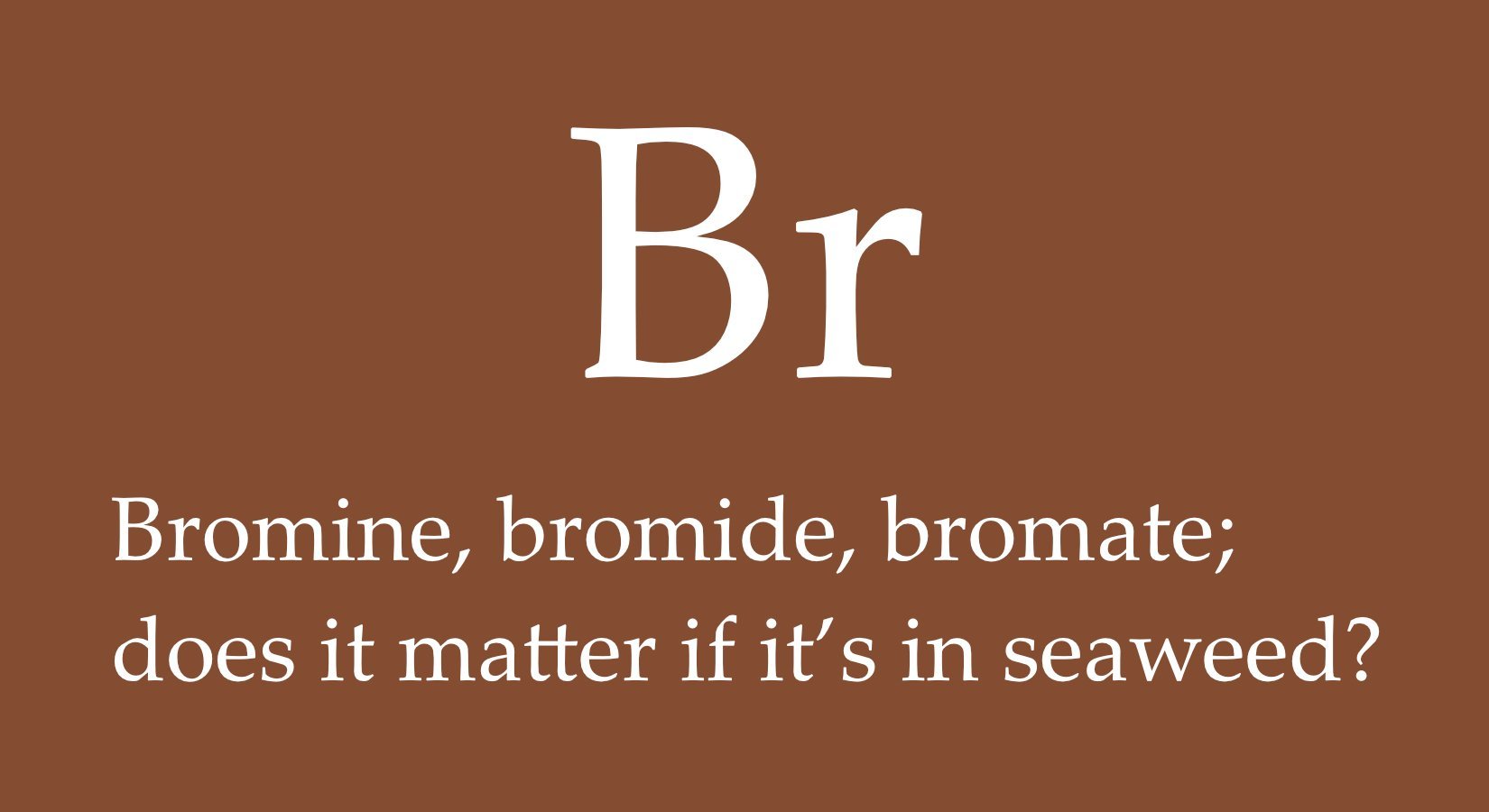Customers sometimes ask about the bromine (or bromide) found in seaweed. Maybe they know that since bromine is the seventh most abundant mineral in seawater, all seafood, including sea vegetables, contains some form of it. Scientists know of over 1,690 naturally occurring organobromine compounds in marine plants and animals. One group of these, known as bromophenols, help give shrimp and other seafood its “ocean flavor”.
Bromine is related to iodine and the other halogen elements fluorine, chlorine, and astatine. The name “halogen” means “salt producing” because the halogens like to form compounds with other elements such as sodium, with bromine in the form of various bromide or bromate compounds. Bromates are often manmade and more harmful to health than bromides, which tend to be more naturally occurring and with a wider range of biological activity.
Because so many of you are health conscious (which may be why you eat seaweed, other than the fact it’s delicious), you often know which foods and substances to avoid. One of these is said to be potassium bromate, because of studies that show it may be carcinogenic. For this reason, many countries around the world ban bromate food additives, though the US doesn’t. Potassium bromate is often added to white flour to improve the rise and elasticity of dough, and health conscious consumers prefer products made with certified organic or unbromated flour.
Bromate can also be found as brominated vegetable oil (BVO) in some soft drinks, especially citrus flavored drinks, where it acts as an emulsifier to keep the oily flavor ingredients homogenous and in suspension. Another source of bromine in food is through fumigation of soil or the food itself with methyl bromide for pest control. Although methyl bromide is being gradually phased out because it depletes the ozone layer, it’s still used on some foods such as conventionally grown grapes and strawberries.
Naturopaths and other healers are concerned that bromine, because it’s so closely related to iodine, may compete with thyroid iodine receptors and cause iodine insufficiency and hypothyroidism. This is sometimes known as the “Bromide Dominance Theory” and Dr. Joseph Mercola was one of the first to popularize this theory on the internet. The theory is based on scientific studies showing adverse effects on the thyroid when bromides are fed to laboratory animals, as well as studies showing a relationship between elevated bromides in people with thyroid disease.
However, a close reading of the scientific literature shows the dangers of bromide don’t quite live up to the sensationalized claims found on many web sites. Perhaps the most important observation is that adverse effects didn’t occur until lab animals consumed very high doses of bromine. The studies also found that the biological activity of bromide depends on the iodine status of the organism. When iodine reserves were adequate, little to no adverse effect on the thyroid was observed from excess bromide, but when iodine reserves were low excess bromide became problematic.
An interesting relationship with chloride was also observed: animals with low chloride levels were more sensitive to bromide and took longer to clear excess from their bodies. Taken together and applied to humans, these results suggest that dietary bromides could be a problem in iodine deficient individuals who regularly consume high amount of bromide or bromate, particularly if those same people limit their salt intake, which is our main source of chloride.
It’s tempting to conclude that dietary bromine should be avoided, and indeed up until recently it was thought that bromine, even though it’s found in almost all plants and animals, was non-essential for life. That thinking changed in 2014, when researchers at Vanderbilt University published a paper in the journal Cell showing that bromine is required in all animals for normal collagen tissue development, making it one of the 28 life-essential elements. However, most people shouldn’t worry about being bromine deficient, because we only require trace amounts and it’s naturally found in almost every food we eat, especially nuts, fish, and seaweed.
Seaweeds absorb bromide ions from seawater much like they do iodine, where it accumulates in their tissues as organic bromide compounds. Although bromide is more plentiful in the ocean than iodine, seaweeds tend to absorb iodine more efficiently and bio-accumulate it at higher levels. Thus, iodine levels are usually higher than bromide in seaweed. In response to customers we tested for bromide in our sea vegetables for several years between 2011 to 2017. On average most of the sea vegetables contained about 650 ppm bromide, but concentrations varied considerably between species. Rockweed was lowest with an average of 488 ppm and sugar kelp the highest, at 1,030 ppm. Levels varied considerably from year to year, even within the same species.
For example, dulse bromide levels were 75 ppm in 2014 and 1,400 ppm in 2016. This is puzzling because bromine is found evenly distributed throughout the world’s oceans and concentrations don’t annually fluctuate. One would therefore expect each seaweed species to contain about the same amount every year. However, studies have shown that bromide is not evenly distributed throughout the seaweed tissue and older tissue may contain more. The annual fluctuations we observed could have been due to different proportions of the thallus (leaf or frond) being included in the sample.
Is bromide in sea vegetables something to be concerned about? Could the bromide found in seaweed adversely affect your thyroid? We think not, in part because seaweed is so iodine rich. Eating seaweed is a great way to ensure adequate iodine reserves, which is why internet sites about bromide often advise us to eat more sea vegetables. The concern about bromine is an example of nutritional reductionism. This is when a particular nutrient, element, mineral, or potentially harmful substance is viewed alone, rather than in the fuller context of a whole food made up of many components.
An example of this is the relationship between Vitamin D and calcium. Both are essential for healthy bones but together they are more effective, and both need to be considered in the context of the food they’re in, along with whatever else is eaten at the same time. Bromide in seaweed is counterbalanced by iodine, though numbers alone don’t tell the whole story. Sea vegetables are an amazingly complex food containing a wide array of ocean minerals, vitamins, and beneficial polysaccharides. These nutrients and compounds all work together to make sea vegetables a life sustaining whole food.



